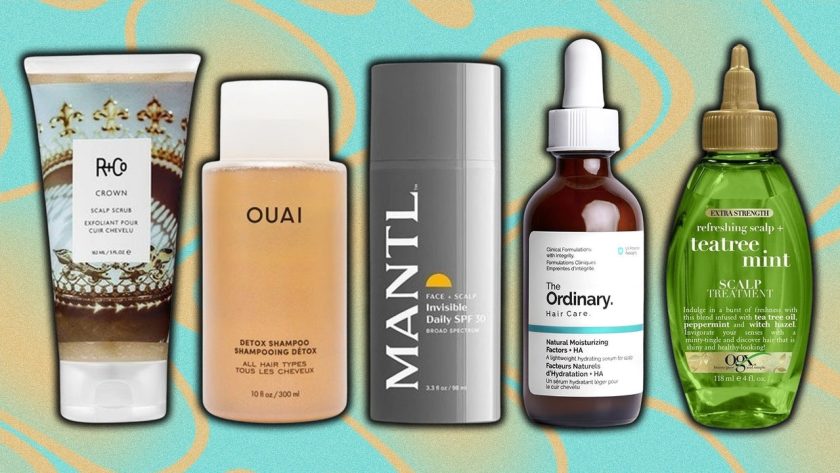Your scalp is the garden bed from which all your luscious hair grows, or it’s bald and beautiful. Maybe it’s somewhere in between, and you’re hoping to save—possibly even regrow—what’s there. Whatever the deal, that soft, sensitive skin stretched across your dome deserves to be coddled and protected. A healthy scalp is a happy scalp. And a happier you.
How you should go about giving your scalp some TLC depends on the specifics of your scalp’s situation. If there’s something slightly off, you can treat it. (We’ve found plenty of products to help if your scalp is dry, oily, inflamed, itchy, or flaky.) If you’re trying to preserve or regrow hair, scalp care is a crucial part of the process. (And we’ve got plenty more advice on beating back hair loss.) If you’re just looking to make your scalp the best it can be, you might start with finding the right shampoo or SPF. It’s not impossible that whatever products are in your shower right now could be the, ahem, root cause of a less-than-perfect scalp situation.
The good news is that you’ve already accomplished step one: thinking more about your scalp’s condition. Below, we’ll walk you through some ways—and a few great products—to give your scalp the love it deserves.
1. Upgrade to a Scalp-Focused Shampoo
Even the best shampoo is basically soap, soap dissolves oils, and oils are what keep your scalp—and your hair—healthy and moisturized. Of course, shampoo also gets rid of accumulated grime, so there’s no avoiding it. The key is to find the right shampoo (or possibly shampoos, plural). One that’s responsive to whatever your scalp needs most. If you’ve just been running with whatever’s cheapest at CVS, this may be the easiest upgrade you’ll make. Here are the different types of shampoos to consider:
Detox Shampoo
A detox shampoo brings a deep clean. A fresh start for your scalp. It’s great for anyone with extremely oily hair—though even then, a detox shampoo is too intense to use more than once a week (or maybe after a hardcore sweat session). Always follow up a detox shampoo with a conditioner and, if possible, a scalp treatment (we’ll get to those in a second). And you’ll probably need a daily go-to shampoo for your more everyday cleaning.
Balancing Shampoo
A balancing shampoo is a step down from a detox shampoo’s scrubdown power, dissolving excess oil while also adding back key nutrients. And unlike detox shampoos, it’ll work as a regular shampoo.
Anti-Dandruff Shampoo
If you’ve got dandruff, you’ll want an anti-dandruff shampoo packed with fungus-fighting ingredients, like ketoconazole, that will shut down flakes, itching, and build-up. (Once you’ve cleared up the flakes, you can transition to a dandruff-preventing shampoo that uses ingredients like sage extract to keep your scalp fungi-free. You can use the preventative stuff maybe once a month as dandruff insurance, or whenever you start to notice some itching or flaking.
2. Add a Targeted Scalp Treatment
Scalp is skin. Like any skin, it’s also happiest when you’re blessing it with the hydration and nutrients it craves. Scalp treatments can be anything: masks, serums, creams, oils, and more. No two provide the same benefits, and they all tend to have their own instructions on how to use and apply. Follow ’em so your scalp gets the best of what they offer, whether that’s moisture or nourishment or prevention.
Scalp Hydrators
These aren’t only for people with routinely dry scalps; we can all use a little hydration, especially after a deep shampooing.
Scalp Clarifiers
These treatments cut through oil, and sometimes use the chemical exfoliation (salicylic acid, witch hazel, and apple cider vinegar are popular ingredients) to rid the scalp of dead skin and keep pores clear.
Scalp Balancers
These treatments will diminish oil, but they’ll also soothe and calm the scalp with ingredients that prevent the kinds of bacterial and fungal threats that lead to itching, inflammation, and flaking.
3. Exfoliate Your Scalp Once a Week
Exfoliating means physically scrubbing off the dead skin cells and sebum that can clog pores and mess with hair follicles. Some of these treatments, serums, masks have chemical exfoliants in their formulas, like salicylic acid and lactic acid—but you can also exfoliate just by using a silicone brush, either with or without a liquid product. Your call! (Just don’t over-exfoliate, and dial it back if your scalp isn’t happy.)
4. Shield Your Scalp From the Sun
You can think of your scalp as an extension of your face, at least when it comes to sun protection. Use SPF face moisturizers or face sunscreens if you’ve got a bald dome or recessed hairline. However, hairlines, bald spots, and cowlicks might be easier to protect with an SPF powder, while buzz cuts and thinning or fine hair could benefit from an SPF spray. (Though the best scalp SPF, of course, is a good hat.)



